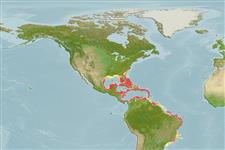Classification / Names
Common names from other countries
Main reference
Size / Weight / Age
Max length : 41.0 cm TL male/unsexed; (Ref. 9710); max. reported age: 11 years (Ref. 36271)
Length at first maturity
Lm 14.7 range ? - 24.5 cm
Environment
Marine; reef-associated; non-migratory; depth range 1 - 150 m (Ref. 26938), usually 1 - 40 m (Ref. 89707)
Climate / Range
Subtropical, preferred 27°C (Ref. 107945); 36°N - 28°S, 98°W - 33°W (Ref. 5222)
Distribution
Short description
Dorsal
spines
(total): 9;
Dorsal
soft rays
(total): 14-16;
Anal
spines: 3;
Anal
soft rays: 9. Body and fins red; many small blue spots edged with black line scattered on body; dorsal edge of caudal peduncle with 2 prominent black spots; a pair of black blotches on tip of lower jaw (Ref. 13608); depth of body 2.6-2.9 in SL; head length 2.3-2.5 in SL; flat interorbital area; rounded preopercle, with shallow notch above the angle with upper edge finely serrate and moderately enlarged, lower edge fleshy; subopercle and interopercle smooth; posterior and anterior nostrils small and subequal; scaly maxilla, reaching to or beyond vertical at rear edge of eye; caudal fin convex posteriorly, corners angular; ctenoid lateral-body scales (Ref. 089707).
IUCN Red List Status (Ref. 115185)
Threat to humans
Reports of ciguatera poisoning (Ref. 30303)
Human uses
Fisheries: commercial; aquarium: commercial
More information
ReferencesAquacultureAquaculture profileStrainsGeneticsAllele frequenciesHeritabilityDiseasesProcessingMass conversion
Tools
Special reports
Download XML
Internet sources
Estimates of some properties based on models
Phylogenetic diversity index
PD50 = 0.5000 many relatives (e.g. carps) 0.5 - 2.0 few relatives (e.g. lungfishes)
Trophic Level
4.1 ±0.4 se; Based on diet studies.
Resilience
Low, minimum population doubling time 4.5 - 14 years (tmax=11; K=0.14-0.63; Fec=67,000-280,000)
Vulnerability
Moderate to high vulnerability (52 of 100)
Price category
